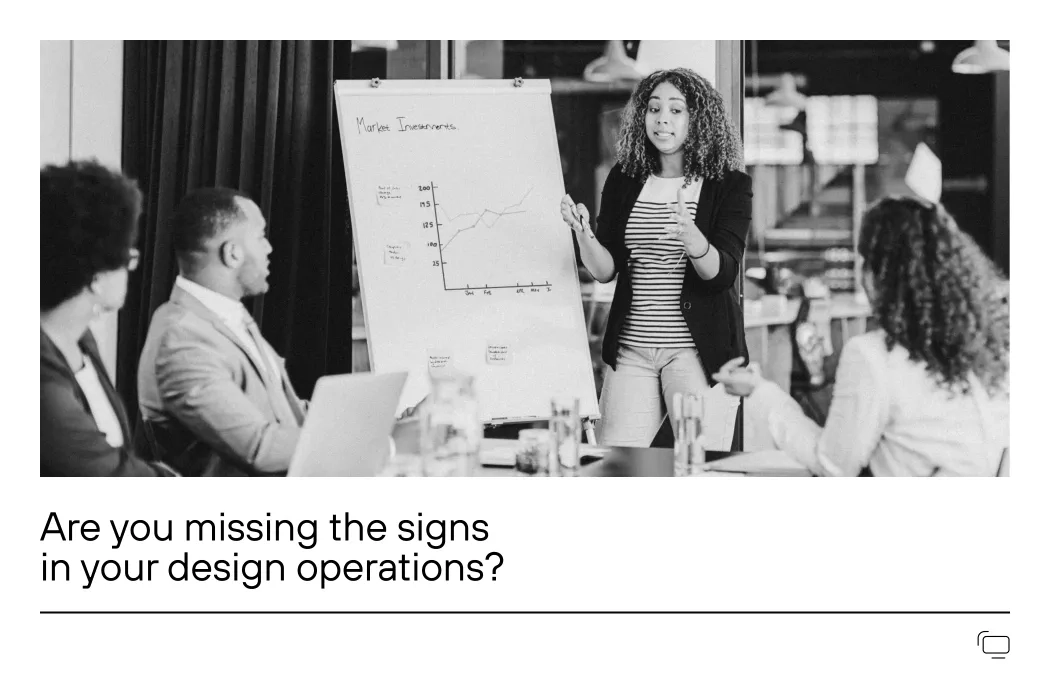
As someone who has been working in design for over a decade, I’ve seen firsthand how a well-structured Design Operation function can transform teams, products, and even entire companies. But I’ve also learned that it’s easy to overlook signs that your design operation needs to evolve. Sometimes they’re subtle; other times they’re right in front of you, but you’re too deep in the daily grind to notice.
Tell me more about Design Operation
In this article, I’ll share five clear signs that your design operation needs to level up, along with tips on how to tackle them, examples from industry scenarios, insights from design leaders, and recommendations for further reading.

Read also: Digital accessibility: inclusive experiences for everyone
Lack of Visibility and Influence in Strategic Decisions
If your design team finds out about strategic decisions after they’ve been made, that’s a red flag.
For example, some teams only receive briefings after their business plans are finalized. This results in rushed, reactive work instead of proactive design leadership. In those cases, teams need to reposition design as a strategic partner. By showing design’s impact with concrete data and storytelling, they can earn a seat at the table.
Industry Insight: According to the Design Management Institute (DMI), design-led companies outperform the S&P 500 by 211% over 10 years. Leadership teams need to understand that design is not just execution — it's strategy.
A strong design operation framework helps ensure that design is represented early and consistently in decision-making processes.
What to do:
- Share regular reports and success stories with leadership.
- Involve designers in discovery and early planning.
- Use metrics that connect design activities to business outcomes.
Inconsistent Processes Across Teams
Do some teams work with Figma, others with outdated Sketch files, and yet others with PowerPoint mockups? Does handoff feel like a wild guess?
For example, some organizations face this early on. Teams use different tools and have their ways of documenting and handing off work. By introducing design system governance and standardized rituals, like design reviews and alignment meetings, they gradually see the benefits.
Quote: "Consistency is one of the most powerful principles of design. It reduces cognitive load and allows teams to move faster." — Jared Spool
Without a solid design operation, process inconsistency becomes the norm rather than the exception.
What to do:
- Audit your current design and delivery processes.
- Create clear, lightweight documentation.
- Foster cross-team conversations to align on practices.
Find out more about Accelerating the Digital Experience Design Process
Low Adoption of the Design System
If your design system feels more like an abandoned library than a living product, that’s a sign.
A common scenario is when companies invest time and effort into building a beautiful design system, but nobody uses it. Often, this happens because teams weren’t involved in its creation or don’t understand how it helps them.
Organizations that succeed here involve designers and developers in co-creation, show adoption metrics, celebrate contributions, and offer regular training opportunities.
NNG Data: According to Nielsen Norman Group, organizations with mature design systems report a 47% increase in efficiency and a 32% reduction in development time.
A robust Design Operation includes governance strategies that drive adoption and ensure ongoing maintenance of design systems.
What to do:
- Involve teams early in design system evolution.
- Track adoption metrics and share progress.
- Make training and support part of your ops plan.
Burnout and Lack of Focus
If your team is constantly firefighting and rarely working on strategic projects, your Design Operation may be missing structure.
For instance, it’s common to hear designers say, “I feel like I’m doing everything and nothing at the same time.” This signals a lack of prioritization and boundaries. Successful teams implement clear prioritization frameworks and collaborate with product managers to separate urgent work from distractions.
Quote: "Focus is not just about saying yes. It’s about saying no to the hundred other good ideas that distract you." — John Maeda
What to do:
- Define clear prioritization frameworks.
- Protect focus time and avoid unnecessary meetings.
- Regularly check in on team workload and mental health.
No Clear Metrics to Prove Impact
If leadership asks, “What’s the ROI of design?” and your answer is vague, you need to evolve.
Mature teams focus on metrics like adoption rate, accessibility compliance, consistency, and satisfaction rates. They also tell stories to contextualize the numbers — data alone isn’t enough. Pairing metrics with narratives helps leadership connect design efforts to business outcomes.
McKinsey’s Business Value of Design Report: Companies with strong design capabilities increase their revenues and shareholder returns at nearly twice the rate of their industry counterparts.
One of the goals of a mature design operation is to establish clear, ongoing metrics that align with business value and prove impact.
What to do:
- Start small with key metrics: adoption, consistency, and satisfaction.
- Connect metrics to business goals (revenue, efficiency, retention).
- Create simple dashboards and share them regularly.
Read: The ROI of UX: Connecting User Experience to Business Success
Bonus Sign: Lack of Continuous Learning
Design maturity is about constant growth. If your team isn’t learning, they’re stagnating.
For example, successful organizations make a habit of publishing articles, hosting internal talks, and creating regular training opportunities. Even a simple 20-minute video can inspire new ideas and approaches.
Organizations with an advanced design operation invest in knowledge-sharing and learning opportunities to elevate the entire team.
Recommendation: Encourage self-learning and offer resources. A small investment in learning yields exponential returns.
Meet Dexa and transform your Design Operation
Final thoughts
Evolving your design operations isn’t about perfection; it’s about progress. Start small, measure what matters, and bring people along for the journey. The more visible and connected your design team is, the more influence you’ll have.
I hope these signs and suggestions help you reflect on where you are and where you can go. And remember, even incremental improvements compound into big wins.
Feel free to reach out or share your own stories. I’d love to hear how your team is evolving.
